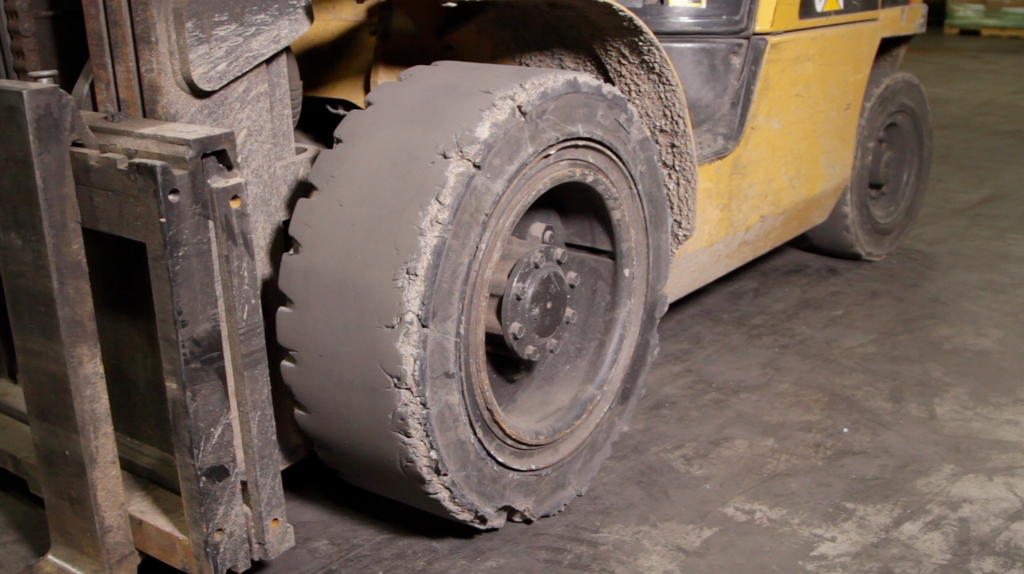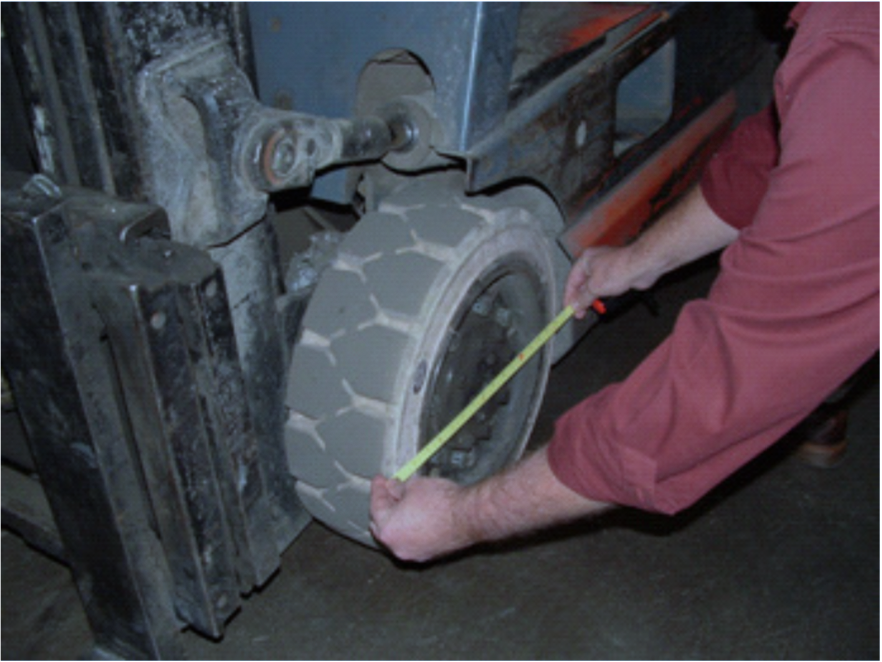When to Replace a Forklift Tire
How to know when you should replace your forklift tires

Author Information:
It is not uncommon for a worn tire to begin to degrade in both performance/ride and appearance. How do we know when tires need to be replaced? Or when has a tire finally worn out and now poses either a potential safety hazard or is causing performance problems?
The following chart shows the approximate diameters (in inches) at which the tire should be replaced due to tread wear (past its useful service life).
| Size | New Tire OD (inch) | Replacement OD (inch) |
|---|---|---|
| 14x4-1/2x8 | 14 | 12-1/2 |
| 16x [5or6] x10-1/2 | 16 | 14-1/2 |
| 16-1/4x [5or6] x11-1/4 | 16/1-4 | 14-3/4 |
| 18x [6,7,8or9] x12-1/8 | 18 | 16-1/2 |
| 21x [7or8] x15 | 21 | 19-1/2 |
| 22x [8,9,10or12] x16 | 22 | 20-1/2 |
| 28x12x22 | 28 |
26-1/2 |
| Size | New Tire OD (inch) | Replacement OD (inc) |
|---|---|---|
| 6.00-9 | 21 | 19 |
| 7.00-12 | 26 | 24 |
| 700-15 | 29 | 27 |
| 750-15 | 30 | 28 |
| 825-15 | 33 | 31 |
| 28x9-15 (8.15x15) | 28 | 26 |
| 250-15 | 29 | 27 |
Please note that this is only a wear guideline. Different tire brands, models and tread patterns may have distinct specifications for outside diameter and width.
However, solid pneumatic or resilient tires may wear beyond the above guidelines, without sacrificing safety or performance. This is due to the fact that there is a large size variance between manufacturers. Please be careful when using the guideline for this type of tire. The technician must closely monitor tires worn beyond the above limits.
Pneumatic tires generally do not follow the above guidelines. Again, this is due to the large size variance between manufacturers, which can be even greater in the pneumatic tire world. The rule of thumb for pneumatic tire replacement is to replace tires before the tread wears out. This means that the center of the tire may be smooth and the outside portion may have some lug or tread showing. Pneumatic tires must be replaced if cuts show cord or frayed cord plies, and/or exposed tire cords.
General Reasons Why A Tire Needs To Be Replaced
There are plenty of other reasons beside a worn diameter for a tire to need replacement, including:
- Traction – Safety
- Ride quality – Increased fuel cost, maintenance and safety
- Clearance between floor and bottom of mast – Increased maintenance cost to equipment and work environment
All are very important and can severely affect a tire’s useful service life in a particular application and must be considered equally in determining when to replace a tire.

Measuring Tire
Always measure overall diameter (OD) from 9 o'clock to 3 o'clock position or from 3 o’clock to 9 o’clock (see image). Record measurement from each tire position.
Measuring tips:
- Measure from to of tread face to top of tread face, not from tread groove to tread groove
- Measure all tires. Often wear will be inconstant from left to right as a forklift often follows a set pattern and may make for turns one direction than the other (directional wear).
- Dual forklifts (two tires side by side on the from) wear very differently on the inside and outside tire as well as left and right sides of the tread face. Make sure you rotate your tires to minimize this wear. Click here to see more on this.

Other Factors
Sometime the size is not the only factor when a tire needs to be replaced.
Pneumatic Tires
- Pneumatic Tires should be replaced whenever there is tire wear or damage that reaches the cords or casing. Forklift tires have roughly 120-185 psi and when they blow, it can do serious harm.
- Lock ring damage - if the lock rings or rim of the wheel is bent from impacts you will need to replace the wheel components to make the tire safe again and quite often the tire may also be damaged causing a separation. Be sure to have a tire technician inspect and damage do to impacts.
Solid Forklift Tires
In most cases, a small cut or even a missing chuck of rubber will not cause a solid forklift tire to fail catastrophically. Knowing what to look for will prevent any unexpected tire change. You should look for:
- Separation of rubber right at the steel band (press on tires)
- Single cracks or cuts that go all the way to the tire base
- Multiple cracks that start at the base and go all the way to the tread face (see picture)
- Tire spinning on the wheel
If you are not sure if the tire should be replaced, please send us pictures (sales@CascadiaTire.com) or call us toll-free at (877) 895-1118 so we can help you.